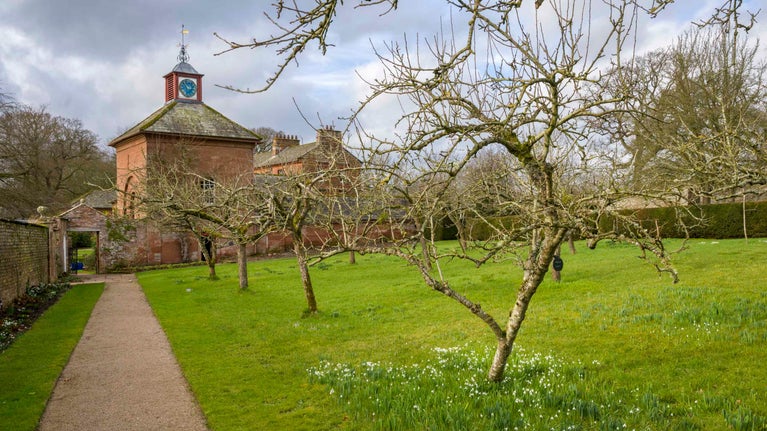
Discover more at Acorn Bank
Find out when Acorn Bank is open, how to get here, the things to see and do and more.

Discover what lies within the garden’s 17th-century walls - stroll through the traditional fruit orchards, see what's on the menu in the vegetable patches and take in the aromas of the herb garden, which is the largest in the National Trust's care and home to over 275 varieties of herbs.
We've planted vegetable beds with pollinator-friendly flowers to attract bees, butterflies and other helpful insects. We hope they might inspire you to have a go at growing fruit and vegetables at home, with handy tips at each bed and examples of what to grow in smaller spaces.
The 17th-century walls shelter the National Trust's largest collection of medicinal and culinary plants in the herb garden, and the traditional orchards are surrounded by herbaceous borders. Beyond the walls, the new orchard contains a growing collection of local apples.
A series of small, linked gardens celebrates continuous development and adaptation over at least 350 years. The first brick-lined walls date from around 1650, originally enclosing a productive vegetable garden with a smaller area for fruit. This was protected by a wall heated with the flue gases from three fires.
By the 1830s the emphasis had moved towards fruit production and more decorative elements. There was also a lower garden on the banks of the Crowdundle Beck which was used to grow vegetables, but this is now woodland.
Dorothy Una Ratcliffe carried on this work in the 1930s and 1940s with a walled garden full of fruit and flowers. She added new and salvaged ornamental ironwork and statuary by creating a wildflower and bird reserve on the bank behind the house and a pond between the house and watermill.
Daffodils and apple trees were protected from the wartime Dig For Victory plough by making a new vegetable-growing area adjacent to the walled garden.
The team at Acorn Bank has directly managed the garden since 1969. The first herb garden was laid out by Graham Stuart Thomas in the smaller of the walled gardens. This herb garden was redesigned and comprehensively replanted in 2003. It now holds over 275 different varieties and is the largest medicinal Herb Garden in the National Trust's care .
We're part of an initiative called 'Silent Space', which was set up in 2016 to invite more peace and quietness into people's lives. Gardens around the country had the opportunity to opt in and offer visitors an area to switch off from technology and stop talking. Every year or two we switch up the location and this year it's in the Herb Garden. All you need to do is put away your phone, close your eyes, take a deep breath and soak up the sounds and smells, as the special collection of plants quietly grow around you.
This Silent Space is available for peace-seekers seven days a week, from 10.30am-5pm.
Want to know more about Silent Spaces? (external link)
The garden is also becoming increasingly known for its orchards. A collection of more than 100 local apple varieties has been established in Dorothy Una Ratcliffe’s vegetable garden, and a succession of manure hotbeds have also been built in this area to provide early salad crops for the tea-room.
At the top of the orchards there is a teaching apiary with four buzzing beehives, which was established by Penrith Beekeepers.

Find out when Acorn Bank is open, how to get here, the things to see and do and more.

Each weekend from 1 February - 16 March we will be open for visitors to come and see the spectacular snowdrop display in the woodland.

Here's your chance to visit whilst the snowdrop displays in the woodland are at their most brilliant; we'll be open each weekend from 1 February - 16 March.

Discover what family-friendly activities are on offer at Acorn Bank in Cumbria, from geocaching around the parkland to newt spotting in the Sunken Garden. Try a self-guided nature trail and use rubbing plaques to discover the flora and fauna of Acorn Bank's walled garden and woodland.

Explore the 180 acres of woodland and parkland at Acorn Bank to visit the historic watermill, get closer to nature, or go on a geocaching adventure.

Discover how Acorn Bank's purpose has changed throughout the centuries, since it was first owned by the Knights Templar in the 13th century.

From 18th-century water gardens and Arts and Crafts landscapes to intimate woodland gardens, there are so many places to discover.

Discover our gardeners’ top tips so you can make the most of your garden, plot or window box.

The Lakes is known for its dramatic, wild landscapes, but it's home to some intriguing gardens too. Explore castle grounds, a cottage garden that inspired Beatrix Potter, and more.